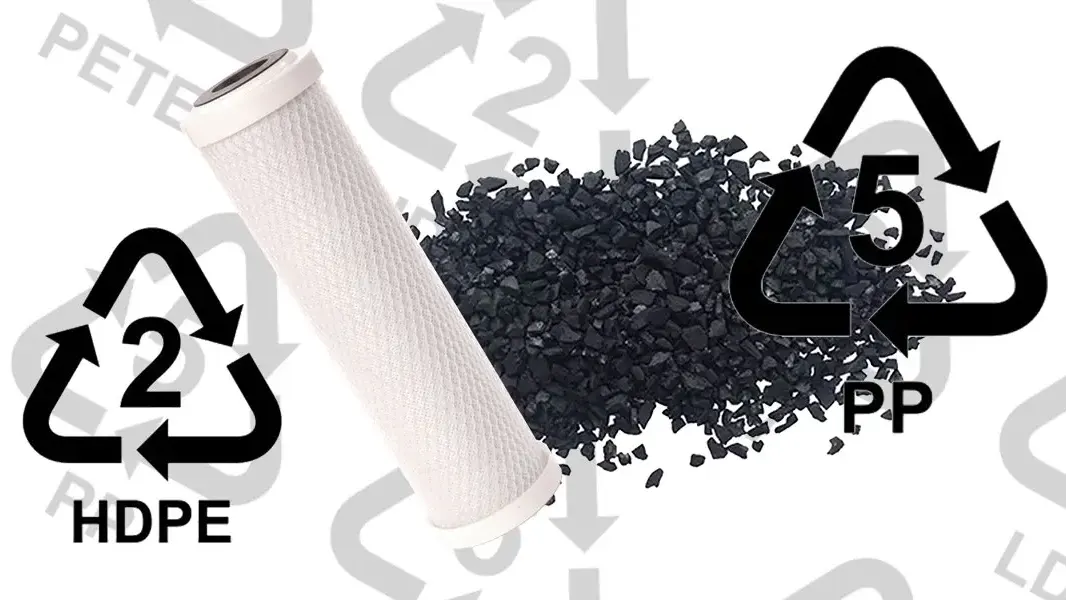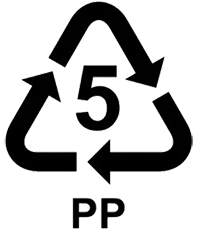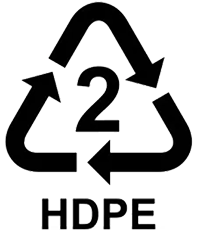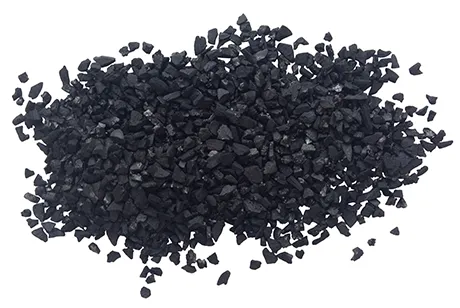How to recycle water filter cartridges correctly
- Products
- by Louise
- 24-08-2023

How to recycle water filters the correct way (by water filter experts)
We are getting asked more frequently about recycling water filter cartridges and how to do it. People are becoming more environmentally conscious and want to play their part.
Firstly, by taking the decision to install a water filter in your home or business you’re already showing a commitment to ditching single use plastic bottles and saving money in the process.
If you want to find out how much you’d be saving by switching to a water filter instead of single use plastic, then look at our handy calculator.
Secondly, we hear a lot of chatter about how we must reduce our carbon footprint. But what does that mean exactly and how does that relate to the disposal of water filter cartridges?
Reducing your carbon footprint means changing how you approach and participate in activities that produce greenhouse gases.
For example, if you want to reduce your carbon footprint at home then you could incorporate these small steps into your household routine:
- properly insulate your home
- lower your thermostat in winter and raise it in summer.
- switch to LED lightbulbs.
- recycle effectively for e.g., water filter recycling.
- turn off lights.
- unplug appliances when not in use.
Fountain Filters actively encourages you to reduce your carbon footprint and we’re going to guide you through how to recycle water filters below.
What are water filters made from?
Water filters, fridge water filters and the cartridges that go inside them are made up of different materials. You might be wondering, with all of these different materials… are all water filter cartridges recyclable? Let’s look at some of those materials before we dive into how to recycle water filters.
Some housings, outer casings of cartridges, cartridges and components can be made from either Polypropylene (PP) or High-Density Polyethylene (HDPE)
 Polypropylene (PP)
Polypropylene (PP)
One of the top five most common plastics. It’s easy to identify. Just look for this image. It’s the number 5 in the chasing arrows symbol. Sometimes, you’ll see a 5 in the symbol and sometimes you’ll see the letters PP underneath the symbol.
PP has good chemical resistance to acids, alkalis, and most solvents. It is also resistant to moisture and has a high melting point so it can be heated. It’s lightweight and strong.
The most common items that you’ll see made of PP are yoghurt pots, margarine containers, syrup bottles, bottle caps, straws, Tupperware, and other plastic food containers, take away food containers, cups, and plates, items used in the automotive industry, sunglasses, cling film, cereal box liners, food packaging e.g., crisp packets, biscuit packets, chocolate bar wrappers.
And of course, Polypropylene is used in the plastic parts of water filters!
 High Density Polyethylene (HDPE)
High Density Polyethylene (HDPE)
As with PP, this is also easy to identify. Just look for this image. It’s the number 2 in the chasing arrows symbol. This stiff, durable, strong, and safe material doesn’t react with food and beverages.
Milk, water and juice bottles, children’s toys, outdoor furniture, shampoo, soap and personal care items, and hard hats are just some of the items made from HDPE.
HDPE is very easy to reuse and recycle.
As with PP, some of the plastic parts of our water filters will be constructed of HDPE.
Some of our cartridges contain loose media such as GAC/KDF, Activated Alumina, and OneFlow.
Granular Activated Carbon (GAC) / Kinetic Degradation Fluxion (KDF)
Used in our Pearl M, Moby M and Doby M water filter cartridges. The type we use are made from coconut shells as they are high in carbon. GAC is effective at removing chemicals from water. KDF is a gold-coloured copper-zinc alloy formulation that helps reduce chlorine, lead, mercury, iron, and hydrogen sulphide from water.
Activated Alumina
We use Activated Alumina media in our fluoride reduction cartridges, such as the Oyster Fluoride water filter. Activated Alumina is an adsorbent for many chemicals including arsenic and fluoride.
OneFlow
Highly effective OneFlow media is used in the majority of our hard water filters such as the Doby Taste and OneFlow. It’s one of the most effective solutions for tackling those pesky limescale problems. OneFlow is a white sand-like substance that circulates with the water flowing through the cartridge. This media uses a process called Template Assisted Crystallisation (TAC) which attract the hard water ions. The TAC and ions combine to make microscopic crystals that detach from the media and then flow away instead of forming limescale.
Carbon Block
Compressed carbon made from coconut shell and a highly effective material for water filtration. We use this in many of our drinking water and mains water filters.
Brass
Components are sometimes used when we build our mains water filters for home and business use.
So, based on what types of materials are used for water filtration products, lets now look at.
How to recycle water filters
If you want to be environmentally conscious at home, it’s important to start looking and becoming familiar with the water filters you have and the packaging they come in. You will also need to familiarise yourself with your local council’s recycling dos and don’ts. If in doubt, please don’t just throw items into your kerbside recycling bins and hope for the best! Read our section on ‘don’t wish cycle’ below.
How to recycle Polypropylene (PP) / High Density Polyethylene (HDPE) filter cartridges
Any rigid plastic parts in our water filter housings, fridge water filters, inline filters, water filter cartridges, empty canisters and components are made of either PP or HDPE. These can be placed in your kerbside recycling bin. Remember to look for the marks if they are there. It’s either: 

If you are in any doubt about recycling PP and HDPE water filter cartridges check with your local council.
But please remember that if there is any loose media inside the rigid plastic part, you must remove it and give the cartridge a rinse before placing in your recycling bin. It’s easy to do this, either by unscrewing the bottom of a cartridge or cutting into the cartridge with something sharp. Please do this carefully to avoid any injuries.
If you ignore emptying the loose media and just throw the entire thing into recycling it will go to landfill and take up to 30 years to decompose. It may also contaminate other items and lead to problems when items are sorted at recycling depots.
 How to recycle Carbon block/GAC filter cartridges
How to recycle Carbon block/GAC filter cartridges
This is an interesting one as there are many uses for both compressed carbon block and granular carbon.
GAC can just be poured out of the plastic canister. The canister normally unscrews at one end. For inline filters you’d have to cut into it and remove the GAC.
Compressed carbon block cartridges are made from coconut shell, such as our Pearl T cartridge. These are totally recyclable after use but takes a little effort. To recycle these type of filter cartridges follow the steps below:
- Remove the plastic ends and put these into your plastic recycling. The caps are glued on can be prised off. This can be done by carefully pushing a blunt knife in, or you could saw off the ends.
- Pull off the plastic mesh and give it a good shake. Put the mesh in your recycling bin after giving it a good shake to remove any remaining carbon. What’s left is the compacted carbon.
- The compacted carbon can be broken up by whatever means you find the easiest.

There are lots of uses for that broken up carbon. Let’s look at how you can recycle the carbon you find in water filter cartridges:
- Break it up into soil, add it to compost or put some in with your pot plants. The carbon will increase aeration, and water retention in the soil. Here’s something to bear in mind though before adding to soil, compost, or pot plants. If you’ve used that filter cartridge to remove contaminants such as heavy metals or arsenic, then the carbon will have trapped and concentrated them. Heavy metals won’t break down further in the compost and may end up in the plants you’re growing.
- Minimise bad smells by rinsing the used carbon grains or broken up compressed carbon in cold water. Then lay it out in the fresh air to dry out. Or inside if it’s raining! Once it’s dry, put the carbon in a sock or cloth bag and leave it in required places like the fridge, the loo, as a car air freshener or a drawer freshener. You can even put it in your smelly trainers or your pet’s bed. It will absorb the smell. Change it as often as your change your water filter cartridge, so every 6-12 months.
- Fight mould by following the process for bad smells above. Leave the sock or cloth bag in any areas where mould is growing or could grow.
How to recycle loose media such as KDF / Activated Alumina / OneFlow
Unfortunately, you’re going to have to put this into your general household waste. There is no way to recycle these kind of filter cartridges but remember, don’t pour the cartridge down the sink or lavatory. Our plumbing and water systems aren’t designed to cope with the materials used in filter media. The media may also contain harmful contaminants that shouldn’t be introduced into the water supply.
How to recycle ceramic water filter cartridges
Using ceramic filters in your compost ensures better water absorption and drainage. To recycle this type of water filter, place the broken ceramic pieces into your compost heap after removing the plastic filter mount. Spread evenly into your compost using a trowel and cover it in compost. You can compost used ceramic water filter cartridges and they’ll help with soil drainage.
How to recycle UV glass lamps and sleeves
If the glass quartz sleeve or lamp is broken do not put it into recycling. Put it out with your general household waste.
How to recycle UV membranes
We are still doing some research into how to recycle UV membranes so for now just place in your general household waste for landfill. Check with your local council if they can be recycled.
How to recycle Brass and other metal components found in filter cartridges
Place in your general household waste. Check with your local council if you are unsure. These will go to landfill.
Plastic components
The plastic components found in filter cartridges should be placed in your general household waste. Check with your local council if you are unsure. These will go to landfill.
How to recycle fridge water filters
Fridge water filters, both internal and external cartridges are essentially made of the same types of material as all other water filters and water filter cartridges. Therefore, when it comes to recycling fridge water filters, these shouldn’t be treated any differently. It’s important to remove all the plastic parts and dispose of any loose media inside – either into general household waste or if it’s GAC, into your garden, compost, or pot plants. Or any of the other fabulous uses as mentioned above.
Don’t Wish Cycle
If you’re not sure about water filter recycling, don’t ‘wish cycle’ it.
Wish recycling is when you toss anything into the recycling bins and hope for the best. We know it’s desirable to feel you’re doing good things, but it’s probably not the best way to go about recycling water filters as you could be causing contamination of actual recyclable materials. And then it would all have to go to landfill, so you’d be doing more harm than good.
But let’s be honest, how often have you just opened the recycling bin and thrown something in thinking that they’ll sort it out at the other end. I know we’ve done it before, have you?
Why we shouldn’t wish cycle
- When recyclable and non-recyclable items are mixed, it can lead to contamination and waste. People working on conveyor belts, or machines, must sort the good from the bad. This takes time, costs a lot of money, and increases rather than decreases waste. If it proves too difficult the whole lot goes to landfill.
- The quality of the recycled products decreases. For example, placing dirty items into recycling can cause trouble such as a paper towel that’s covered in grease or oil. The oil can mix with other non-soiled paper or towels and cause holes which renders the clean paper useless in recycling terms.
- Non-recyclable items can damage machinery which costs money and time.
Manufacturers recycling information
We’ve looked at some of our manufacturer’s websites to see what information they have about recycling water filters. The results are not startling, but what we have found is listed below. We will update this section as and when we find additional information.
- Doulton – there is limited information on their website but as they manufacture ceramic cartridges, these can be recycled. Look at the information about how to recycle ceramic cartridges above.
- Argonide – All components in the NanoCeram and Deal water filter cartridges are constructed of food grade materials and basically harmless. They can be disposed of in kerbside recycling. However, the cartridges cannot be scrubbed down and reused even though it’s tempting to get a bit more use out of them. This is because they are final barrier/dead end filters.
- Water to Go – There is lots of valuable information about how to recycle water filters on their website. Water to Go products are 100% recyclable so you can dispose of them sustainably. The casing and end caps can go in your plastic recycling, and the grey membrane can then go on your compost heap and biodegrade.
- Samsung – after a very long and protracted online chat with Samsung technical support they said they could not answer our questions about water filter recycling. However, as the outer canister of most of their filters is PP or HDPE, these can be recycled once the media contained within the cartridge is removed.
- 3M – there is some information on their websites water filter cartridge product pages. Outer casings are made of polypropylene so can be recycled. See information about PP and HDPE above.
What if to do if your water filter cartridges aren’t recyclable
If recycling water filter cartridges isn’t an option for you because you’re buying a brand that isn’t recyclable, the most obvious thing to do is change to a brand that is.
Other than that, just place in your normal household waste and they will go to landfill.
What we’re currently doing at Fountain Filters
We don’t currently offer water filter recycling services, but this is something that is set to change soon. We will update this blog when things are in place.
However, to reduce our carbon footprint and be more environmentally conscious here’s what we are doing.
- We re-use our cardboard packaging. We do treat ourselves to corrugated brown paper and other brown paper to wrap cartridges, so they are protected when we dispatch them. Other than that, we don’t believe in sending out products in new fancy cardboard boxes. What matters is that the product inside is going to solve your water filtration problems. We hope that once you receive your parcel, that you re-use as much of the packaging as you can.
- We break cardboard boxes up to use as void fills in boxes.
- We avoid bubble wrap like the plague. But if some is sent to us, we re-use it.
- If we have a product that is returned for whatever reason, we re-purpose the parts of it that we can. It’s very rare that we get returns so this doesn’t happen often. We don’t ever re-purpose damaged items. That would be wrong.
- When customers are buying water filter cartridges containing loose media, we encourage them to buy the media only. This saves on plastic waste as the canisters can be emptied and reused. (links here to loose tac and fluoride media)
As you can see, recycling water filter cartridges is relatively straightforward. If in any doubt about any aspect of water filter recycling, please give us a call on 01352 838 281, send us a message or contact your local council.


